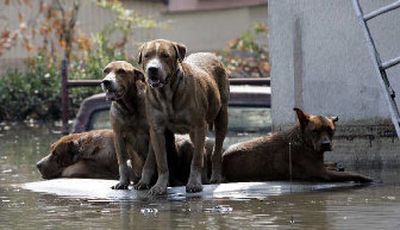Local couple race time to save pets

As human survivors caught in the aftermath of Hurricane Katrina are evacuated and floodwaters begin to recede, several animal protection organizations have begun rescuing pets left behind in the disaster.
“In New Orleans alone we are talking tens of thousands of animals,” said Dick Green, of Spokane, director of Animal Emergency Services for the American Humane Association based in Englewood, Colo. “We have no idea how many are going to be alive.”
On Wednesday, Green was coordinating animal rescue efforts from the association’s mobile animal rescue unit in Lafayette, La., where his team is supporting an emergency animal shelter in Blackham Coliseum.
The shelter was set up to accept pets from evacuees who could not take them along to refugee centers. So far, the shelter has taken in 306 animals, mostly dogs and cats, but the occasional snake or ferret, Green said.
Green, 54, a former Gonzaga University professor of exercise physiology and biomechanics and employee of the Spokane Regional Health District, was appointed to the American Humane Association position on Sept. 1. But he has extensive experience as a volunteer with animal rescue operations, including missions to Sri Lanka after last December’s tsunami. Green’s team is working in cooperation with the Animal Rescue League of Boston and United Animal Nations, among other groups.
Green and his team of as many as 24 volunteers are trained in swift-water rescue, high- and low-incline rescue and helicopter operations. After Hurricane Floyd struck the U.S. East Coast in September 1999, Green said, he was involved in helicopter rescues of as many as six horses a day.
Earlier this week, Green was coordinating two water rescue teams in New Orleans. The teams go door to door extracting animals reported left behind by their owners. He said many people who fled Katrina could not bring their pets with them. Now, many of the animals left behind are starving, dehydrated or sick from drinking contaminated water. There were reports this week of authorities in New Orleans shooting stray animals, including dogs that reportedly have begun traveling in packs.
“I’m spread a little thin,” Green said. As soon as he can get a team of volunteers into Lafayette to take over support operations at the shelter, he planned to take his emergency rescue unit to Gonzalez, La., where most water and land rescues of New Orleans are being staged.
Green coordinates animal rescue operations from the association’s Animal Emergency Services unit, an 82-foot semi-tractor trailer rig, which serves as a command center, mobile veterinary clinic and temporary shelter for displaced animals.
The unit is entirely self-contained with a 300-gallon water tank, power generator, communications equipment and residential facilities, including kitchen, bathroom and bunks for up to 12 rescue personnel. The rig carries an ambulance, a 14-foot johnboat, three Zodiac inflatable boats and engines.
One of the unit’s Zodiacs was recently stolen, Green said, but nevertheless he had three boats on the water on Tuesday. The teams are trained just as they would be to rescue humans, but with animal-handling skills as well.
“You can imagine what a cat will do, especially a feral cat,” Green said.
Animal rescue teams such as Green’s waited nearly a week for permission to enter some disaster areas from authorities whose first priority was evacuation of human survivors. But Green said he has been coordinating his response plan since two days before the storm hit. His first team was on the ground in Mississippi the day after the hurricane.
Green said on a good day his teams can rescue 100 animals. Water rescues can average about six per hour.
His wife, Sue Anderson, a veterinarian’s assistant, plans to join her husband in Louisiana on Sunday. Anderson, also a flight attendant with Alaska Airlines, said she has flown two trips to New Orleans to pick up survivors and fly them to Texas. The couple lives near Mount Spokane.
Green’s group has been trying to reunite rescued pets with their owners using a national database of animals missing in the storm and resulting floods, which wiped out local humane societies just like everything else.
“All we can do is get them (pets) in a central area, photograph them and get them posted on the Web,” Green said. “It’s a nightmare.”
He said if owners had just gone out with their animals when they were first told to, none of this would have been necessary. The stories he hears from despondent pet owners are very similar:
“‘I left my dog because there were six of us in the car.’ Or, ‘We thought it wouldn’t be that bad,’ ” Green recounted. “It is hard to understand what they were thinking.”